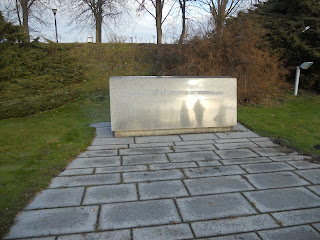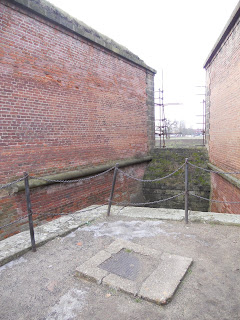I made the reservation for the day after we arrived. I wasn't sure when my daughter and her boyfriend were leaving the Czech Republic, so I made sure we would be able to visit the day after we all arrived in Prague. We were scheduled to meet the bus at 8:30 at the hotel where my daughter and her boyfriend were staying. This meant we had to eat breakfast and head out from the flat where we were staying to catch our tram by 8:00. There was definitely a feeling of being rushed.
Our hostess had promised to have our breakfast ready by 7:15. We were amazed by the breakfast she presented. We had soft-boiled eggs, sliced salamis, cucumber slices, pineapple slices, orange sections, cheeses, yogurt, cereal, milk, orange juice, coffee, toast, rolls, butter and cookies. There was so much food, I think I must have gasped. We both ate what we could, but left more than half untouched. It was simply too much. We wondered what our hostess must have thought of us that she prepared so much food.
Well fed, we headed off on the tram toward downtown Prague. Our hostess had indicated where we would disembark and how to get to the hotel. It couldn't have been easier.
Once in the lobby of the hotel, we looked for my daughter and her boyfriend. I called up to their room and realized I woke them. They hastened downstairs and in very little time the driver arrived. I wasn't completely clear on how this tour would work, but the plan slowly revealed itself. We boarded a minivan joining a few other passengers. The driver collected a few more passengers before stopping at St. Wenceslas Square. Once there, we pulled up behind another minivan and were told to board yet another van designated for English and Italian speakers. Our guide boarded last and then we headed out of town.
Our guide narrated bits and pieces about Prague as the driver headed northwest about 40 miles toward Terezin. One of the tidbits the guide shared was that the Vietnamese controlled the clothing market for average consumers. He said high end consumers purchased designer brands. He continued to offer some observations, but the sound was rather muffled and it was hard to discern what he was saying. As we continued driving on the motorway through the countryside, he pointed out other sites, including a castle fortress atop a hill which had imprisoned a young king. Meanwhile, left to my own devices, I saw three hawks, a crane and two deer in a field. Cindy saw a man with a goat. As we neared Terezin we drove through a few villages. There were some lovely chateaus, as well as damaged homes and apartment houses.
Finally, we arrived at the small fortress of Terezin. It was actually bigger than I anticipated. We passed through a cemetery outside the fortress itself. There were burial sites for both Christians and Jews.
We also saw concrete blocks containing the ashes of some who perished within the prison walls.
Shortly after its construction, the fortress served as a military penitentiary, or Festungs Stockhaus. It was also used to imprison those who opposed the Hapsburg monarchy.
During World War I, the fortress served as a prison camp. In fact, Gavrilo Princip, the man who assassinated (and thus launched the "War to end all wars") Archduke Franz Ferdinand and his wife, died in cell one at the end of the war.
The Gestapo used the small fortress as a prison, and the town as a ghetto for the Jews of the Czech Republic, as well as Jews from other European nations.
A sign inside the fortress gates reads: "In the years 1940-1945 more than 1500 Jews were imprisoned in the Small Fortress. Their destiny was worst of all the groups of prisoners. About 500 of them were tortured to death here, most of the others perished after the deportation to the concentration camps."
All tolled, about 32,000 prisoners spent time in the Small Fortress. One of the books I bought said "Famine, epidemics, inhuman treatment, and executions ended 2,600 lives, including those of 500 women. Another
5,500 prisoners died after deportations to Nazi concentration camps, penitentiaries and prisons."
The fortress, surrounded by a moat, worked well as a prison, but more on that later.
We passed beneath the typical "Arbeit Macht Frei" sign as we entered the prison proper.
Another guide took up the tour inside the prison walls, and this was a good thing. Susanna, our "inside" guide, took pains to remark how the Jews were singled out for particularly cruel treatment. We saw isolation cells designed to hold one prisoner, but were used to hold 12. One such location had a glass roof and windows which didn't open. Susanna said people imprisoned in this cell often died from the extreme heat.
Susanna told us about medical attention for prisoners which was never extended to Jews. When Typhus broke out in the camp, prisoners were isolated and no one was allowed in or out of the area. Those who were sick received no visits by doctors. The food came in buckets. It's not hard to imagine that many of the sick prisoners went hungry for lack of energy to crawl over to the buckets, thus hastening their deaths.
We learned that doctors performed some surgeries, such as amputations, but with sub-par equipment.
We saw the shower rooms where prisoners were allowed to take a shower once a month.
We saw machines where prisoners removed their clothes for delousing.
We learned that the delousing process was worthless because it used steam only. Without delousing chemicals the lice remained.
Susanna told us that there had been only one successful escape. Three men secreted a ladder and breached the walls.
We saw tunnels which had been built in the 18th century as means of escaping the Prussians. It's not surprising that these tunnels were all barricaded during World War II to prevent escape.
Walking through these tunnels took much longer than I had anticipated. I'm not the only one of our group who suffers from claustrophobia. We were assured that there were lights which would dissipate some of the anxiety, or so they said. Still, it took a really long time to get through these tunnels, and I, for one, had my moments.
When we emerged from the tunnels, we saw a shooting site which sent shivers up our collective spines.
Prison guards would lie down in this form and take aim at the prisoners lined up in front of this wall.
 |
| Execution squads killed 51 prisoners without benefit of trial. |
Susanna told us it had been used only once, but one of my books said 16 prisoners were executed there for minor offenses.
There were a number of stunning sculptures on site as well.
 |
| This sculpture is called "Violence". |
I found this empty swimming pool to be one of the most disturbing sights at Terezin.
The idea of people enjoying themselves in the midst of all this suffering is off-putting, to put it mildly.
We saw a short film before leaving the Small Fortress, which included some scenes of the infamous Red Cross visit to the Thereisenstadt ghetto. However, time was running very short and we did not have the opportunity to go to the onsite museum. One young man who chose to visit the museum didn't make it in time to board the bus, although we learned that he was able to catch up a bit later.
Our original guide resumed "leadership" of our tour, taking us to a museum in the town.
It's a good museum with exhibits modeling the living spaces of the more than 150,000 men, women and children who spent at least some of the war there. We weren't allowed to take photos within the museum, but one of the books I purchased reported that "About 35,000...found death in Terezin; another 83,000 died after deportations from Terezin in extermination camps, concentration camps and death marches towards the war's end." Civilians had been required to leave Terezin by mid-1942.
The museum featured some impressive art, literature, music and theater exhibits. Once again, we had the experience of an extensive set of displays with insufficient time to peruse them.
Our next stop was the crematorium and cemetery.
Similar to the Small Fortress site, there were sections in the cemetery for both Jews and Christians. The guide pointed out that the Christian section was for Russian soldiers.
As was true at the Terezin musuem, they didn't allow photos inside the crematorium. I did manage to take this shot of the edifice outside the crematorium.
I looked up the question as to why the owl adorned the edifice of the crematorium. A page on owls said,
"In early Rome a dead Owl nailed to the door of a house averted all evil that it supposedly had earlier caused. To hear the hoot of an Owl presaged imminent death."
The crematorium was an interesting site, but also very disturbing. The man who supervised the site spoke only Czech, but managed to convey his wish for people to buy candles and to refrain from taking photos. He also seemed to have some old communist literature.
I was so disappointed not to see more of the "ghetto" of Terezin. The story of the ghetto is amazingly rich and disturbing. Labeled "Hitler's Gift to the Jews", the ghetto went through a "Beautification Action" to fool the Red Cross Committee delegation. Members of the delegation were treated to a children's performance of the opera called "Brundibar" (The Bumblebee). Beyond that one cynical day, there were a number of legitimate acts of artistic and cultural resistance. The first Baeumler Kaplan commemoration with which I was affiliated featured a book of remembered recipes which had been collected by the women at Terezin called, "In Memory's Kitchen." A few years ago, we featured Ellen Kennedy, the former director of the Center for Holocaust and Genocide Studies. Kennedy had visited the ghettos at Vilna and Terezin and told the story of Vedem, a collection of philosophical and political essays, poetry and short fiction, art and comics put together by young boys of the Terezin school. The museum did cover much of this material, but it would have been so much better to spend more reflective time in the ghetto.
We were back on the bus before too long, headed back to Prague. There wasn't as much chatter on the way back to the city.
We were dropped off on Wenceslaus Square, and we found a Lebanese restaurant for lunch. Our food was very tasty, but there were a number of people smoking which was unpleasant.
After walking through town and back to the Sheraton where Leah and Mike were staying, we managed to surf the Internet and hang out in their room for a few hours. Finally, Cindy and I had dinner around the corner from the Sheraton. Once again, the restaurant was so smoky I felt choked by it.
We made it back to our room and watched "Hot in Cleveland" and "The Survivor" in Czech. It lost its charm in short order.
.
























No comments:
Post a Comment